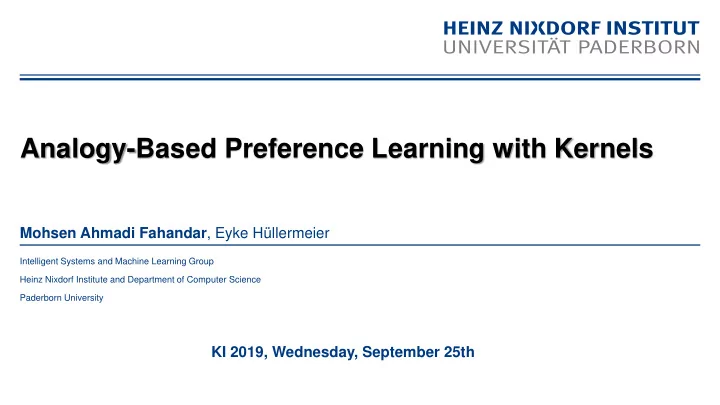

Analogy-Based Preference Learning with Kernels Mohsen Ahmadi Fahandar , Eyke Hüllermeier Intelligent Systems and Machine Learning Group Heinz Nixdorf Institute and Department of Computer Science Paderborn University KI 2019, Wednesday, September 25th
Our Contribution Generalized (fuzzy) Equivalence Relations Kernel-based Machine Learning Analogical Reasoning 2 Intelligent Systems and Machine Learning
Analogical Reasoning Formalization of analogical reasoning based on the notion of analogical proportion (Miclet and Prade 2009; Prade and Richard 2017) : :: : (pictures from ImageNet) 3 Intelligent Systems and Machine Learning
Analogical Proportions Domain-based instantiation Mathematically, a predicate on four objects Formalizing the “as” part Satisfy the set of axioms 4 Intelligent Systems and Machine Learning
A nalogical Proport ions ( numerical case) Generalization of Boolean case: the four objects are in analogy to some degree Example o o o 5 Intelligent Systems and Machine Learning
Ext ension t o Feat ure Vect ors Extension from individual attributes to feature vectors 6 Intelligent Systems and Machine Learning
Analogy and Kernels Key observation analogical proportion (by definition) defines a kind of similarity similarity measure Image from https://testinternetspeed.org/blog/internet-connection-speed/ 7 Intelligent Systems and Machine Learning
Bridging Concept Hence capture the notion of similarity o Reflexive o Symmetric o T-transitive 8 Intelligent Systems and Machine Learning
Connection Motivation: certain types of fuzzy equivalence relations satisfy the properties of a kernel function (Moser 2006) Kernel-based Machine Learning 9 Intelligent Systems and Machine Learning
Kernels Symmetric Positive semi-definite kernel trick linearization 10 Intelligent Systems and Machine Learning
Analogical Proportions as Kernels: analogy-kernel 11 Intelligent Systems and Machine Learning
Kernel-preserving Operations Extending the analogy-kernel from individual variables to feature vectors To allow for incorporating a certain degree of non-linearity 12 Intelligent Systems and Machine Learning
An Application: Preference Learning Query Predicted Ranking Ground Truth Ranking (normalized) ranking loss: 13 Intelligent Systems and Machine Learning
Inference Pattern (Ahmadi Fahandar and Hüllermeier AAAI-2018) Analogy assumption : :: : (pictures from ImageNet) + Known knowledge (presumably) 14 Intelligent Systems and Machine Learning
Analogy-Kernel-Based Object Ranking (AnKer-rank) 1. Pairwise preference: 2. Rank aggregation : This preference relation is turned into an overall consensus ranking 15 Intelligent Systems and Machine Learning
AnKer-rank: 1. Prediction of Pairwise Preferences Predictions in the unit interval using Platt-scaling (Plat 1999) 16 Intelligent Systems and Machine Learning
AnKer-rank: 2. Rank Aggregation Bradley-Terry-Luce (BTL) model (Bradley and Terry 1952) Predicted ranking: sort objects in descending order of their estimated parameter Ahmadi Fahandar et al., Statistical Inference for Incomplete Ranking Data: The Case of Rank-Dependent Coarsening (ICML 2017) 17 Intelligent Systems and Machine Learning
Baselines Nearest Neighbor-based principle able2rank (Ahmadi Fahandar and Hüllermeier AAAI-2018) Linear Regression-based principle Expected Rank Regression ( ERR ) (Kamishima et al., 2010; Kamishima and Akaho 2006) SVM-based principle RankingSVM (Joachims 2002) Neural Network-based principle RankNet (Burges et al., 2005) 18 Intelligent Systems and Machine Learning
19 Intelligent Systems and Machine Learning
Experimental Setup AnKer-rank and able2rank : Rescaling of feature vectors to take values in the unit interval ERR, RankingSVM and RankNet : Standard normalization Hyper-parameters: fixed using (internal) 2-fold CV (repeated 3 times) 20 Intelligent Systems and Machine Learning
Quite competitive in terms of predictive accuracy On a par with able2rank and Ranking SVM ERR and RankNet show worse performance 21 Intelligent Systems and Machine Learning
Summary and Future Work Connecting kernel-based machine learning and analogical reasoning in the context of preference learning Building on the observation that analogical proportions define a kind of similarity Utilizing generalized (fuzzy) equivalence relations as a bridging concept Introducing analogy-kernel Advocating a concrete kernel-based method for object ranking First experimental results on real-world data from various domains are quite promising To study kernel properties of other analogical proportions (e.g., geometric) My homepage To study other types of applications, whether in preference learning or beyond To study the use of kernel-base methods other than SVM https://github.com/mahmadif/able2rank THANKS 22 Intelligent Systems and Machine Learning
Recommend
More recommend